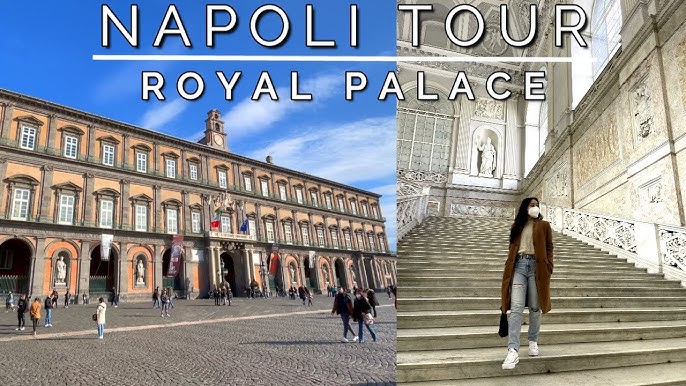The Palazzo Reale di Napoli, or Royal Palace of Naples, stands proudly in Piazza del Plebiscito, one of Naples’ most famous squares. With its grand architecture, rich history, and breathtaking art, the palace offers visitors a unique glimpse into the royal past of Naples. This guide explores the palace’s history, architectural highlights, must-see rooms, and practical visitor information for an unforgettable visit to this iconic Neapolitan landmark.
History of Palazzo Reale di Napoli
The construction of the Palazzo Reale began in 1600 when the Spanish viceroy Fernando Ruiz de Castro commissioned the architect Domenico Fontana to design a palace fit for royalty. Originally intended as a residence for King Philip III of Spain, the palace grew into a residence for Naples’ various ruling dynasties. Under Spanish, Austrian, and eventually Bourbon rule, the palace became a center of power and culture. Each dynasty brought new additions and renovations to the palace, reflecting the changing architectural tastes of the time, from Renaissance and Baroque to Neoclassical influences.
When the Kingdom of Italy was unified in 1861, the palace came under the control of the House of Savoy, who made further renovations. Despite damages during World War II, the palace remains a monument to Naples’ grandeur and royal history.
Architectural Highlights of the Royal Palace
The Palazzo Reale di Napoli combines Renaissance and Baroque styles with a few Neoclassical additions. Standing at four stories, the palace facade is impressive, adorned with statues of important rulers who shaped the history of Naples, such as Charles V, Victor Emmanuel II, and Charles III. This architectural beauty continues throughout the palace’s interior, which is filled with art, frescoes, and antique furnishings.
- The Courtyards: The palace features four primary courtyards, each exuding elegance and grandeur. The most famous is the Courtyard of Honor, or Cortile d’Onore, known for its harmonious design of columns and arches.
- The Grand Staircase: One of the palace’s standout features is the Scalone d’Onore, a grand staircase designed by the architect Luigi Vanvitelli. Its marble steps and elegant design make it one of the finest examples of Neapolitan architecture.
- The Royal Chapel: The Cappella Reale is an ornate chapel within the palace, decorated with intricate frescoes, golden details, and a magnificent altar. The chapel highlights Naples’ deep Catholic heritage and devotion.
Must-See Rooms Inside the Palace
The Palazzo Reale di Napoli is filled with rooms that showcase the royal lifestyle of former Neapolitan monarchs. Here are some rooms not to miss:
- The Throne Room: The grandest room in the palace, the Throne Room features crimson walls, gilded mirrors, and crystal chandeliers. The throne, set against a dramatic backdrop, reflects the palace’s regal atmosphere.
- The Hall of Hercules: This majestic hall is adorned with a fresco depicting the myth of Hercules, symbolizing strength and resilience. This Baroque masterpiece is one of the most iconic rooms in the palace.
- The Hall of Ambassadors: Used to welcome foreign dignitaries, this room features large tapestries and grand frescoes that narrate Naples’ rich history. Its decor underscores the importance of diplomatic relations during the monarchy.
- The Royal Apartments: These apartments give visitors a more personal glimpse into the lives of Naples’ former royalty. Lavishly decorated, they include private bedrooms, reception rooms, and studies filled with antique furnishings.
- The Court Theatre: The Teatrino di Corte is a small but stunning theater used for private performances. Decorated in Neoclassical style, the theater remains one of the palace’s most charming spaces.
The Royal Gardens
The palace’s gardens are equally impressive, offering a tranquil retreat from the city’s bustling streets. The Giardino Romantico, or Royal Garden, is designed in the romantic style, with pathways lined by lush greenery, fountains, and sculptures. Additionally, the Giardino Pensile, or Hanging Garden, offers views of Mount Vesuvius and the Bay of Naples, adding to the palace’s natural beauty.
Visiting Palazzo Reale di Napoli
Location: The Royal Palace is located in Piazza del Plebiscito, Naples, making it easily accessible by public transportation or on foot from many parts of the city.
Opening Hours: Generally, the palace is open from 9:00 a.m. to 8:00 p.m., though hours may vary by season. Checking the official website before visiting is recommended to confirm hours and avoid closures.
Admission Fees: Entry fees are required, but discounted rates are available for students, seniors, and EU citizens. Visitors can also enjoy free entry on the first Sunday of each month.
Tours and Guides: Guided tours provide in-depth information on the palace’s history and architecture. Audio guides are available in several languages for those who prefer a self-guided experience.
Tips for a Great Visit
- Arrive Early: The palace can be crowded, especially during weekends and holidays, so arriving early helps avoid the crowds.
- Photography: Photography is generally allowed, but flash photography is restricted to preserve the artworks and furnishings.
- Take Your Time: With so many rooms and features to explore, plan at least two hours to fully appreciate the palace.
Conclusion
A visit to the Palazzo Reale di Napoli is a journey into the heart of Naples’ royal past. From its majestic rooms and impressive courtyards to its serene gardens, the palace offers a rich cultural experience that captures the essence of Neapolitan heritage. Whether you’re a history buff, an art lover, or simply a curious traveler, the Royal Palace of Naples is a must-see destination that promises to leave you inspired by the legacy of Italian royalty.




